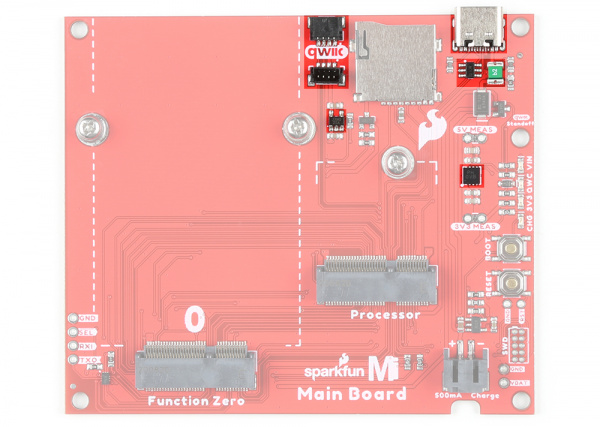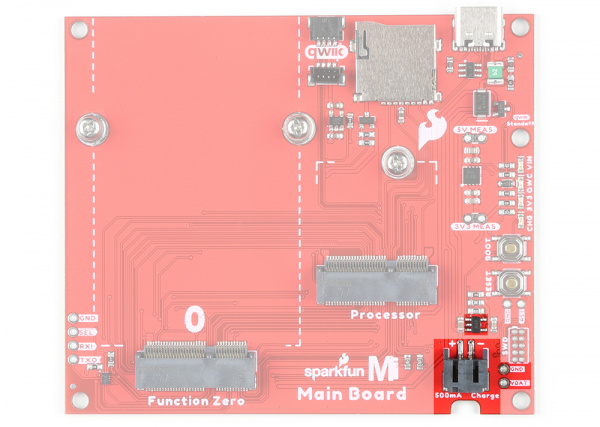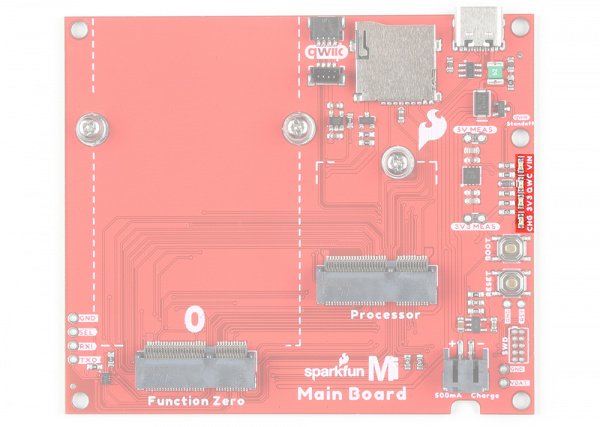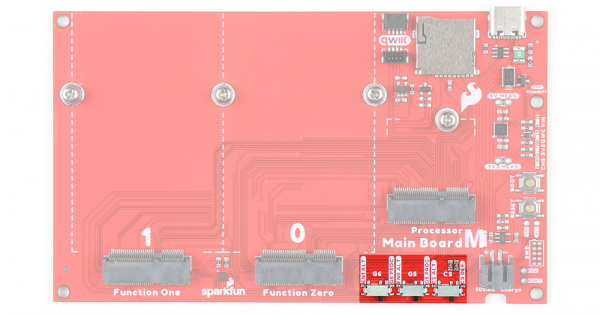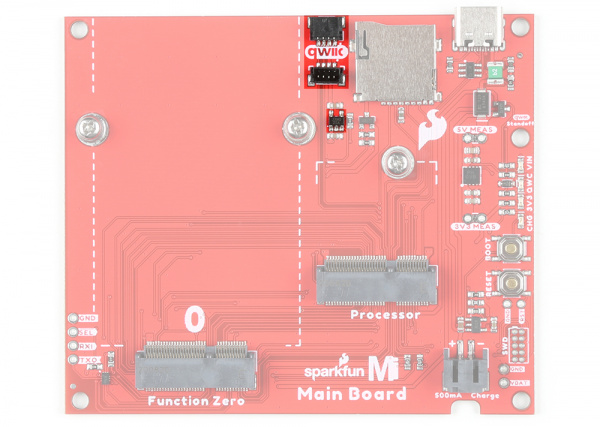MicroMod Main Board Hookup Guide V2
Hardware Overview
The overall functionality of the Single and Double Main Boards are the same. We'll use the Single Main Board more in this section to highlight the features since this is also included in the Double Main Board. We'll switch to the Double Main Board when necessary to highlight the features that are only included in the Double Main Board.
The differences are that the Double Main Board includes:
- 3x switches
- two for the 3.3V power enable pins
- one for the secondary SPI CS pin
- ability to add a second MicroMod Function Board to the mix
- board's width
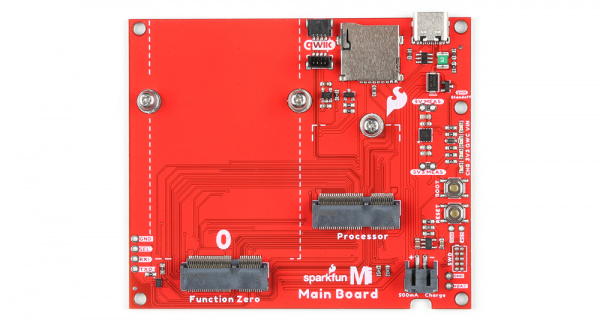 |
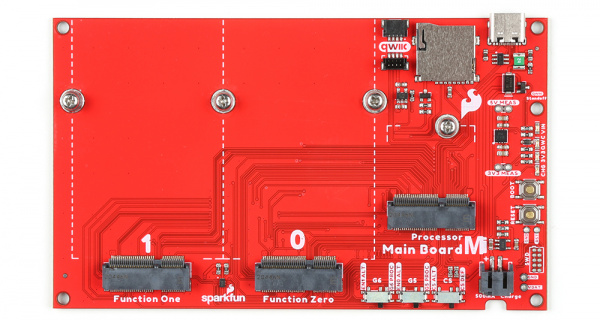 |
| Main Board - Single V2.1 | Main Board - Double V2.2 |
Revision Changes
The following changes to the Main Board Single V2.1 and Main Board Double V2.2 include:
- Rotate silkscreen for the connectors and a majority of the labels.
- Add TVS diodes for ESD protection on the USB pins.
- Add SHLD jumper to isolate the USB Type C connector's shield pin.
- Add a 5V MEAS PTH jumper as a measurement for 5V.
- Remove the 500mA/100mA selector for the LiPo charge circuit. The board now charges at a default rate of 500mA only.
- Add a DIVIDER jumper to remove the resistor divider that is connected to processor's "BATT_VIN/3" pin for low power applications.
- Add a dedicated 3.3V/500mA voltage regulator for the Qwiic port.
- Add GPIO control of 3.3V voltage regulator (I2C_SCL1-Processor).
- Add a LED for the 3.3V Qwiic port with a QWIIC LED jumper to disable.
- Add a transistor to disable power to the microSD socket (can be controlled using I2C_SCL1-Processor).
- Add multiplexed primary UART pins to send serial data to Function Board(s).
- Add PTH pins for multiplexed UART (Main Board Single v2.1 only).
- Move PWR_EN0 from SDIO_Data2_Processor to PWM1 (Main Board - Single v2.1 only)
- Add two 2.2kΩ I2C pull-ups to the primary I2C pins with jumpers (I2C) to disable.
- Replace male header pins and 2-pin shunt with SMD switches to adjust the Function Board Power enable pins (Main Board - Double v2.2 only).
- Add option to adjust Function Board One's secondary SPI CS pin (i.e. "CS1-processor" and "A1-processor") with a SMD switch (Main Board - Double V2.2 only).
Power
There are two ways to power the Main Boards, Processor Board, and Function Board(s).
- USB
- Single Cell LiPo Battery
It is fine to connect a power source to the USB connector and LiPo battery's JST connector at the same time. The MicroMod Main Board has power-control circuitry to automatically select the best power source.
Power USB
One option of powering the board is through the USB Type C connector. You will need a USB Type C cable to power the board with 5V. Power connected to the board's USB C connector will go through a resettable PTC fuse (rated at 2A max) and then the AP7361C 3.3V voltage regulator (rated at 1A max). The little green component close to the USB connector is the resettable PTC fuse while the square IC is the voltage regulator. The voltage regulator accepts voltages between ~2.2V to 6.0V. For Main Boards V2+, there are now ESD protection diodes (the 6-pin IC next to the fuse) on the USB data lines. There is also now an additional AP7347DQ 3.3V voltage regulator (rated at 500mA) for the Qwiic connectors. The voltage regulator accepts voltages between ~1.7V to 5.5V.
Power LiPo
The other option is to connect a single cell LiPo battery (i.e. nominal 3.7V, 4.2V fully charged) to the 2-pin JST connector as shown below. For users interested in soldering headers, wire, or measuring a LiPo battery, the VBAT and GND is broken out next to the connector. A MCP73831 charge IC is included on the boards to safely charge the LiPo batteries via USB Type C connector. A corresponding status LED (labeled as CHG, not highlighted in the image below) will indicate when the board is charging or is fully charged. More information on the LED status is highlighted in the LEDs section. For Main Boards V2+, the default charge rate is now set to 500mA only. We recommend that users only use a single cell LiPo battery with a capacity of 500mAh or higher to safely charge the battery. There is also a small cutout on the edge of the board allowing users to place a LiPo battery underneath the board if they decide to place the board in an enclosure.
The voltage from the LiPo battery is then regulated down to 3.3V as it goes through the AP7361C 3.3V voltage regulator (rated at 1A max) for the rest of the board. The voltage is regulated down to 3.3V as it goes through the Qwiic connector's AP7347DQ 3.3V voltage regulator (rated at 500mA max) as well.
MicroMod Processor Board
The MicroMod ecosystem allows you to easily swap out processors depending on your application. The location of the M.2 connector labeled as Processor is where you would connect and secure a MicroMod Processor Board.
MicroMod Function Board
Beside the MicroMod Processor's socket is another M.2 connector for MicroMod Function Boards, which allow you to add additional functionality to your Processor Board. The Single Main Board includes one M.2 connector for a single Function Board while the Double Main Board includes two M.2 connectors for up two Function Boards.
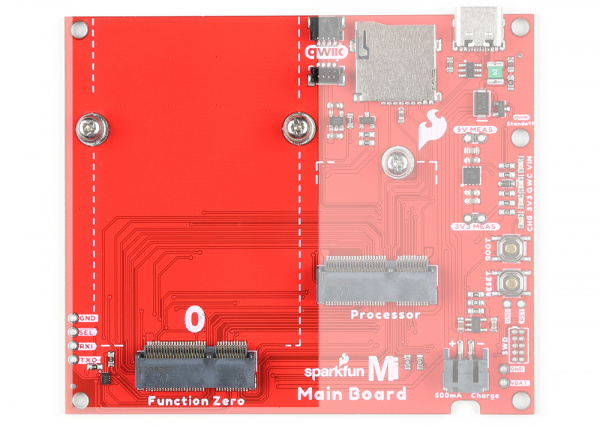 |
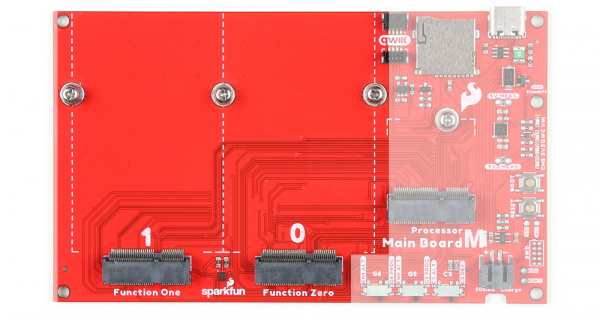 |
| Main Board - Single Function Board Location | Main Board - Double Function Board Location |
Reset and Boot Buttons
Each board includes one button for the RESET and another button for the BOOT. There is an additional reset and GND PTH pin next to the reset button. Hitting the reset button will restart your Processor Board. Hitting the boot button will put the Processor Board into a special boot mode. Depending on the Processor Board, this boot pin may not be connected.
SWD Pins
For advanced users, we broke out the 2x5 SWD programming pins. Note that this is not populated so you will need a compatible header and compatible JTAG programmer to connect.
MicroSD Card Socket
The board includes a microSD socket if your application requires you to log and save data to a memory card. The primary SPI pins (SDO, SDI, SCK) from your Processor and Function Board are connected to the microSD card socket. The CS pin for the microSD card socket is different on each board:
- The MicroMod Main Board - Single v2.1 is on Processor Board's pin
D1. - The MicroMod Main Board - Double v2.2 is on Processor Board's pin
G4.
For Main Boards V2+, there is a transistor (the tiny three pin IC below the microSD card socket) to toggle power to the microSD card socket's VCC pin. This is connected the Processor Board's secondary I2C clock pin (i.e. "I2C_SCL1") and is active low. For users using the Main Boards in low power applications, you can define the pin and set it to a logic HIGH to disconnect power connected to the microSD card socket. Setting the pin to a logic LOW will power the microSD card socket. Just make sure to close the file to avoid any corrupt data.
LEDs
There are four LEDs on the board:
- VIN - The VIN LED lights up to indicate when power available from the USB connector.
- QWC - The QWC LED lights up to indicate when there is a 3.3V available to the Qwiic connector after power is regulated down from the USB connector or LiPo battery. This is a new feature that was added in Main Boards v2+.
- 3V3 - The 3V3 LED lights up to indicate when there is a 3.3V available for the MicroMod Processor Board and Function Boards after power is regulated down from the USB connector or LiPo battery.
- CHG - The on-board yellow CHG LED can be used to get an indication of the charge status of your battery. Below is a table of other status indicators depending on the state of the charge IC.
| Charge State | LED status |
| No Battery | Floating (should be OFF, but may flicker) |
| Shutdown | Floating (should be OFF, but may flicker) |
| Charging | ON |
| Charge Complete | OFF |
Jumpers
The following ten jumpers are included on both the Single and Double Main Boards.
- SHLD - By default, the jumper is closed and located on the bottom side of the board. This jumper connects the USB Type C connector's shield pin to GND. Cut this to isolate the USB Type C connector's shield pin. This is a new feature that was added in Main Boards v2+.
- 5V5 MEAS - By default, the jumper is closed and located on the top side of the board. This jumper is used to measure your system's current consumption. You can cut this jumper's trace and connect the PTHs to a ammeter/multimeter to probe the input into the 3.3V voltage regulator. Check out our How to Use a Multimeter tutorial for more information on measuring current. This is a new feature that was added in Main Boards V2+.
- 3V3 MEAS - By default, the jumper is closed and located on the top side of the board. This jumper is used to measure your system's current consumption. You can cut this jumper's trace and connect the PTHs to a ammeter/multimeter to probe the output from the 3.3V voltage regulator.
- PTC - By default, the jumper is open and located on the bottom of the board. For advanced users, add a solder blob to the jumper to bypass the resettable PTC fuse to pull more than 2A from the USB source.
- 3V3 EN - By default, this jumper is open and located on the bottom of the board. Closing this jumper enables processor control of the 3.3V bus.
- VIN LED - By default, this jumper is closed and located on the bottom of the board. Cut this trace to disable the LED that is connected to the input of the USB.
- QWIIC LED - By default, this jumper is closed and located on the bottom of the board. Cut this trace to disable the LED that is connected to the output of the Qwiic connector's 3.3V voltage regulator. This is a new feature that was added in Main Boards V2+.
- 3V3 LED - By default, this jumper is closed and located on the bottom of the board. Cut this trace to disable the LED that is connected to the output of the 3.3V voltage regulator.
- DIVIDER - By default, this jumper is closed and located on the bottom of the board. This is connected to processor's "BATT_VIN/3" pin. This is for advanced users that want to remove the resistor divider in low power applications.
- I2C - By default, this 3-pad jumper is closed by default and located on the bottom of the board. The 2.2kΩ pull-up resistors are attached to the primary I2C bus; if multiple devices are connected to the bus with the pull-up resistors enabled, the parallel equivalent resistance will create too strong of a pull-up for the bus to operate correctly. As a general rule of thumb, disable all but one pair of pull-up resistors if multiple devices are connected to the bus. This is a new feature that was added in Main Boards V2+.
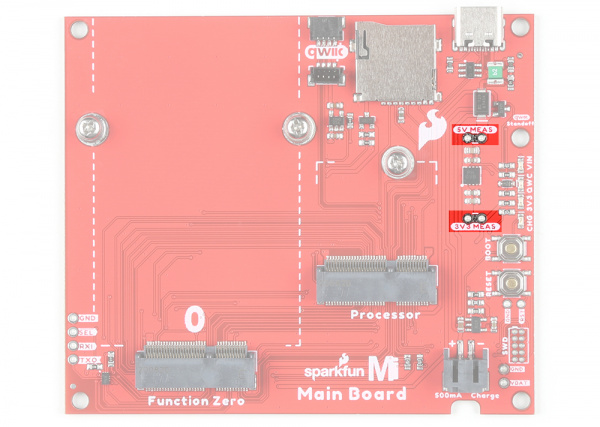 |
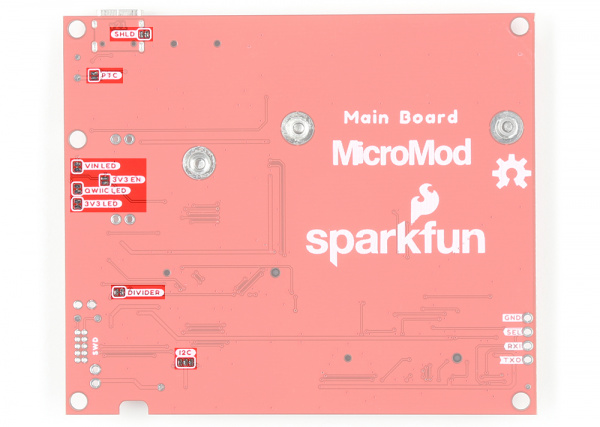 |
| Main Board - Single Top View Jumpers |
Main Board - Single Bottom View Jumpers |
Switches
Certain processors have limited GPIO (e.g. SAMD51, ESP32, and STM32 to name a few) and so these alternative power enable pins have been provided. The previous version of the Main Board Double used male jumper pins and 2-pin shunts for each Function Board power enable pin. For the Main Board Double v2.2, these are now replaced with SMD switches. There is an additional switch for the CS pin for users that require the use of more than one SPI chip select pin. Simply move the switch toward the side that fits your project's needs. The list below explains where the pins are routed when the switch set to each side. Make sure to check the hookup guide for your Processor and Function Board for more information about the the pin definitions.
- G6
- EN1_ALT - Setting the G5 switch toward the EN1_ALT position will route the Processor Board's
G6toSDIO_DATA1. As stated earlier, this is needed for Processor Boards that do not have aSDIO_DATA1pin. Thus a general purpose pin was used as an alternative pin. - G6 PROC - Setting the switch toward the G6 PROC position will route the Processor Board's
G6pin to the Function Board One's general purpose pin (i.e. FC1's "F4" pin).
- EN1_ALT - Setting the G5 switch toward the EN1_ALT position will route the Processor Board's
- G5
- EN0_ALT - Setting the G5 switch toward the EN0_ALT position will route the Processor Board's
G5toSDIO_DATA2. As stated earlier, this is needed for Processor Boards that do not have aSDIO_DATA2pin. Thus a general purpose pin was used as an alternative pin. - G5 PROC - Setting the switch toward the G5 PROC position will route the Processor Board's
G5pin to the Function Board One's general purpose pin (i.e. FC1's "F3" pin).
- EN0_ALT - Setting the G5 switch toward the EN0_ALT position will route the Processor Board's
- CS
- CS_ALT - Setting the CS switch toward the CS_ALT position will route the Processor Board's secondary SPI chip select pin
CS1pin toA1. As stated earlier, this is needed for Processor Boards that do not have aSDIO_DATA3pin. In this case, an analog pin was used for the alternative pin. - CS DEF - Setting the switch toward the CS DEF position will route the Processor Board's CS1 pin to the Function Board One's chip select pin (i.e. FC1's "F1/CS" pin).
- CS_ALT - Setting the CS switch toward the CS_ALT position will route the Processor Board's secondary SPI chip select pin
Multiplexed Primary UART
For Main Boards V2+, a multiplexer was added after the Processor Board's primary UART pins (i.e. TX1 and RX1). Most users will not need to worry about using the multiplexer, which should be connected to Function Card 0's default UART pins (i.e. FC0's "Rx" and "TX" pins).
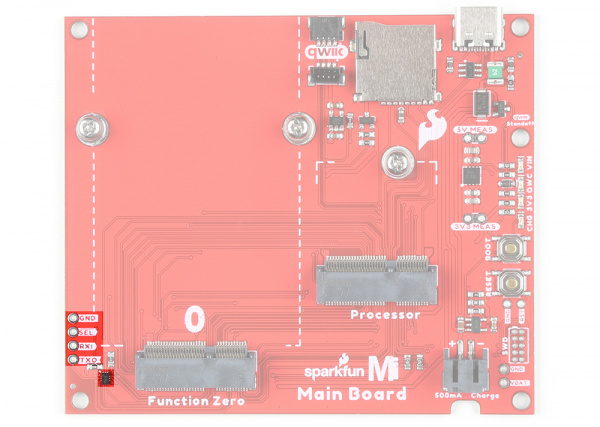 |
 |
| MicroMod Main Board - Single Mux and PTH Pins | MicroMod Main Board - Double Mux |
For those that have certain Function Boards that require device firmware updates (DFU), users will need to configure the multiplexer's input pins "1IN" and "2IN" by pulling either pin low. Setting "1IN" to LOW will route primary UART lines to Function Card Zero's multiplexed pins (i.e. FC0's "DFU_FC_TX and "DFU_FC_RX" pins). Setting "2IN" to LOW will route primary UART lines to Function Card One's multiplexed pins (i.e. FC1's "DFU_FC_TX and "DFU_FC_RX" pins). The MicroMod Cellular Function Board - Blues Wireless Notecarrier is one board that takes advantage of this feature. Since the Main Board Single V2.1 only has one location for a Function Board, the second set of multiplexed pins are broken out to a row of PTH pins (i.e. GND, SEL, RXI, TXO). Below is the truth table for the multiplexer. For more information, make sure to check out the respective schematics to view where the pins are connected.
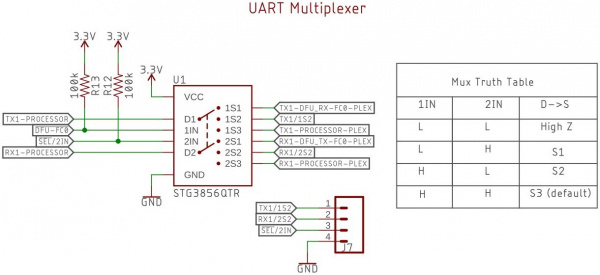 |
 |
| Screenshot of the UART Multiplexer from the Main Board Single V2.1 Schematic |
Screenshot of the UART Multiplexer from the Main Board Double V2.2 Schematic |
Having a hard time seeing the schematic? Click on the image for a closer look.
Qwiic and I2C
The board includes a vertical and horizontal Qwiic connector. These are connected to the primary I2C bus on both the Processor and Function Board connectors allowing you to easily add a Qwiic-enabled device to your application. For Main Boards that are V2+, the 3.3V pin is connected to its own dedicated 3.3V voltage regulator as explained earlier. The I2C data and clock lines are also tied to 2.2kΩ pull-up resistors.
Note that there are two mounting holes for Qwiic-enabled boards that have a standard 1.0"x1.0" size board. The image below highlighted with a black square is where you would place the board.
MicroMod Pinout
Depending on your window size, you may need to use the horizontal scroll bar at the bottom of the table to view the additional pin functions. Note that the M.2 connector pins on opposing sides are offset from each other as indicated by the bottom pins where it says (Not Connected)*. There is no connection to pins that have a "-" under the primary function.
| AUDIO | UART | GPIO/BUS | I2C | SDIO | SPI | Dedicated |
| Processor Pins | Function Zero Pins | Main Board - Single Miscellaneous Pins |
|
|---|---|---|---|
| USB_VIN | - | USB_VIN | |
| USB_D+_Processor | USBHOST_D+ | USB_D+ | |
| USB_D-_Processor | USBHOST_D- | USB_D- | |
| USB_D+_Processor | USBHOST_D+ | USB_D+ | |
| USB_D-_Processor | USBHOST_D- | USB_D- | |
| 3.3V | - | 3.3V | |
| 3.3V_EN | - | 3.3V_EN | |
| BATT_VIN / 3 | - | VIN/3 | |
| GND | GND | GND | |
| RESET | DFU_RST | RESET Button RST PTH |
|
| BOOT | DFU_BOOT | Boot Button | |
| SWDCK_Processor | - | SWDCK (2x5 Header) | |
| SWDIO_Processor | - | SWDIO (2x5 Header) | |
| D0_Processor | INT | F0 | - |
| D1_Processor | - | SD Card CS (microSD Card) |
|
| I2C_SDA_Processor | I2C_SDA | I2C_SDA (Qwiic Connector) | |
| I2C_SCL_Processor | I2C_SCL | I2C_SCL (Qwiic Connector) | |
| I2C_INT_Processor | I2C_INT | - | |
| I2C_SDA1_Processor | - | SD_ENABLE (microSD CardPower) |
|
| I2C_SCL1_Processor | - | QWIIC_EN | |
| UART_TX1_Processor | UART_RX (DFU_Active [FC0] = HIGH,SEL = HIGH) |
TXO (DFU_Active [FC0] = HIGH,SEL = LOW) |
|
| DFU_FC_TX (DFU_Active [FC0] = LOW,SEL = HIGH) |
|||
| UART_RX_Processor | UART_TX (DFU_Active [FC0] = HIGH,SEL = HIGH) |
RXI (DFU_Active [FC0] = HIGH,SEL = LOW) |
|
| DFU_FC_RX (DFU_Active [FC0]= LOW,SEL = HIGH) |
|||
| UART_RTS_Processor | UART_CTS | - | |
| UART_CTS_Processor | UART_RTS | - | |
| - | - | SEL | |
| PWM0_Processor | PWM0 | F2 | - |
| PWM1_Processor | PWR_EN0 | - | |
| A0_Processor | A0 | - | |
| CAN_RX_Processor | CAN_TX | - | |
| CAN_TX_Processor | CAN_RX | - | |
| G0_Processor | F3 | - | |
| G1_Processor | F4 | - | |
| G2_Processor | F5 | - | |
| G3_Processor | F6 | - | |
| G4_Processor | F7 | - | |
| SPI_CS0_Processor | CS | F1 | - |
| SPI_SCK_Processor | SPI_SCK | SPI_SCK (microSD Card) |
|
| SPI_DI_Processor | SPI_DO | SPI_DO (microSD Card) |
|
| SPI_DO_Processor | SPI_DI | SPI_DI (microSD Card) |
|
| Processor Pins | Function Zero Pins |
Function One Pins |
Main Board - Double Miscellaneous Pins | ||
|---|---|---|---|---|---|
| USB_VIN | - | - | USB_VIN | ||
| USBHOST_D+_Processor | USBHOST_D+ | (No USB Host) | - | ||
| USBHOST_D-_Processor | USBHOST_D- | (No USB Host) | - | ||
| USB_D+_Processor | - | - | USB_D+ | ||
| USB_D-_Processor | - | - | USB_D- | ||
| 3.3V | - | - | 3.3V | ||
| 3.3V_EN | - | - | 3.3V_EN | ||
| BATT_VIN / 3 | - | - | VIN / 3 | ||
| GND | GND | GND | GND | ||
| RESET | DFU_RST | DFU_RST | RESET Button RST PTH |
||
| BOOT | DFU_BOOT | DFU_BOOT | Boot Button | ||
| SWDCK_Processor | - | - | SWDCK (2x5 Header) | ||
| SWDIO_Processor | - | - | SWDIO (2x5 Header) | ||
| I2C_SDA_Processor | I2C_SDA | I2C_SDA | I2C_SDA (Qwiic) | ||
| I2C_SCL_Processor | I2C_SCL | I2C_SCL | I2C_SCL (Qwiic) | ||
| I2C_INT_Processor | I2C_INT | - | I2C_INT | ||
| I2C_SDA1_Processor | - | - | SD_ENABLE | ||
| I2C_SCL1_Processor | - | - | QWIIC_EN | ||
| UART1_TX_Processor | UART_RX (DFU_Active [FC0] = HIGH,(DFU_Active [FC1]= HIGH) |
- | - | ||
| DFU_FC_TX (DFU_Active [FC0] = LOW,(DFU_Active [FC0]= HIGH) |
DFU_FC_TX (DFU_Active [FC1] = HIGH,(DFU_Active [FC1] = LOW) |
||||
| UART_RX_Processor | UART_TX (DFU_Active [FC0] = HIGH,(DFU_Active [FC1] = HIGH) |
- | - | ||
| DFU_FC_RX (DFU_Active [FC0] = LOW,(DFU_Active [FC1] = HIGH) |
DFU_FC_RX (DFU_Active [FC0] = HIGH,(DFU_Active [FC1] = LOW) |
||||
| UART1_RTS_Processor | UART_RTS | (No Flow Control) | - | ||
| UART_CTS_Processor | UART_CTS | (No Flow Control) | - | ||
| UART2_TX_Processor | - | UART_RX | - | ||
| UART2_RX_Processor | - | UART_TX | - | ||
| D0_Processor | F0 | INT | - | - | |
| D1_Processor | - | F0 | INT | - | |
| PWM0_Processor | PWM | F2 | - | - | |
| PWM1_Processor | - | PWM | F2 | - | |
| A0_Processor | A0 | - | - | ||
| A1_Processor | - | A0 | CS1_ALT Switch | ||
| CAN_RX_Processor | CAN_TX | (No CAN BUS) | - | ||
| CAN_TX_Processor | CAN_RX | (No CAN BUS) | - | ||
| G0_Processor | F3 | - | - | ||
| G1_Processor | F4 | - | - | ||
| G2_Processor | F5 | - | - | ||
| G3_Processor | F6 | - | - | ||
| G4_Processor | F7 | - | SD Card CS (microSD Card) |
||
| G5_Processor | - | F3 | PWN_EN0_ALT SWITCH | ||
| G6_Processor | - | F4 | PWN_EN1_ALT SWITCH | ||
| G7_Processor | - | F5 | - | ||
| SPI_CS0_Processor | SPI_CS1 | F1 | - | - | |
| SPI_CS1_Processor | - | SPI_CS1 | F1 | CS1_ALT Switch | |
| SPI_SCK_Processor | SPI_SCK | SPI_SCK | SPI_SCK (microSD Card) |
||
| SPI_DI_Processor | SPI_DO | SPI_DO | SPI_DO (microSD Card) |
||
| SPI_DO_Processor | SPI_DI | SPI_DI | SPI_DI (microSD Card) |
||
| SDIO_CLK_Processor | - | F7 | - | ||
| SDIO_CMD_Processor | - | F6 | - | ||
| SDIO_DATA1_Processor | - | PWR_EN1 | PWN_EN1_ALT SWITCH | ||
| SDIO_DATA2_Processor | PWR_EN0 | - | PWN_EN0_ALT SWITCH | ||
| Alternative Function |
Primary Function |
Bottom Pin |
Top Pin |
Primary Function |
Alternative Function |
|---|---|---|---|---|---|
| (Not Connected) | 75 | GND | |||
| VIN | 74 | 73 | 3.3V | ||
| VIN | 72 | 71 | Power EN | ||
| - | 70 | 69 | - | ||
| DFU_RST | 68 | 67 | - | ||
| DFU_BOOT | 66 | 65 | - | ||
| - | 64 | 63 | - | ||
| - | 62 | 61 | F7 | ||
| - | 60 | 59 | F6 | ||
| - | 58 | 57 | F5 | ||
| - | 56 | 55 | F4 | ||
| - | 54 | 53 | F3 | ||
| - | 52 | 51 | F2 | PWM | |
| - | 50 | 49 | F1 | SPI_CS | |
| - | 48 | 47 | F0 | INT | |
| - | 46 | 45 | GND | ||
| - | 44 | 43 | CAN_TX | ||
| - | 42 | 41 | CAN_RX | ||
| EEPROM_WP | 40 | 39 | GND | ||
| A0 | 38 | 37 | USBHOST_D- | ||
| EEPROM_A0 | 36 | 35 | USBHOST_D+ | ||
| EEPROM_A1 | 34 | 33 | GND | ||
| EEPROM_A2 | 32 | 31 | Module Key | ||
| Module Key | 30 | 29 | Module Key | ||
| Module Key | 28 | 27 | Module Key | ||
| Module Key | 26 | 25 | Module Key | ||
| Module Key | 24 | 23 | I2C_INT | ||
| - | 22 | 21 | I2C_SCL | ||
| - | 20 | 19 | I2C_SDA | ||
| UART_CTS | 18 | 17 | - | ||
| UART_RTS | 16 | 15 | UART_RX | ||
| - | 14 | 13 | UART_TX | ||
| - | 12 | 11 | - | ||
| DFU_FC_ACTIVE | 10 | 9 | - | ||
| - | 8 | 7 | SPI_SDO | ||
| DFU_FC_RX | 6 | 5 | SPI_SDI | ||
| DFU_FC_TX | 4 | 3 | SPI_SCK | ||
| - | 2 | 1 | GND |
| Alternative Function | Alternative Function | Alternative Function | Primary Function | Bottom Pin |
Top Pin |
Primary Function | Alternative Function | Alternative Function | Alternative Function |
|---|---|---|---|---|---|---|---|---|---|
| (Not Connected) | 75 | GND | |||||||
| 3.3V | 74 | 73 | G5 / BUS5 | ||||||
| RTC_3V_BATT | 72 | 71 | G6 / BUS6 | ||||||
| SPI_CS1# | SDIO_DATA3 (I/O) | 70 | 69 | G7 / BUS7 | |||||
| SDIO_DATA2 (I/O) | 68 | 67 | G8 | ||||||
| SDIO_DATA1 (I/O) | 66 | 65 | G9 | ADC_D- | CAM_HSYNC | ||||
| SPI_POCI1 | SDIO_DATA0 (I/O) | 64 | 63 | G10 | ADC_D+ | CAM_VSYNC | |||
| SPI PICO1 | SDIO_CMD (I/O) | 62 | 61 | SPI_POCI (I) | |||||
| SPI SCK1 | SDIO_SCK (O) | 60 | 59 | SPI_PICO (O) | LED_DAT | ||||
| AUD_MCLK (O) | 58 | 57 | SPI_SCK (O) | LED_CLK | |||||
| CAM_MCLK | PCM_OUT | I2S_OUT | AUD_OUT | 56 | 55 | SPI_CS# | |||
| CAM_PCLK | PCM_IN | I2S_IN | AUD_IN | 54 | 53 | I2C_SCL1 (I/O) | |||
| PDM_DATA | PCM_SYNC | I2S_WS | AUD_LRCLK | 52 | 51 | I2C_SDA1 (I/O) | |||
| PDM_CLK | PCM_CLK | I2S_SCK | AUD_BCLK | 50 | 49 | BATT_VIN / 3 (I - ADC) (0 to 3.3V) | |||
| G4 / BUS4 | 48 | 47 | PWM1 | ||||||
| G3 / BUS3 | 46 | 45 | GND | ||||||
| G2 / BUS2 | 44 | 43 | CAN_TX | ||||||
| G1 / BUS1 | 42 | 41 | CAN_RX | ||||||
| G0 / BUS0 | 40 | 39 | GND | ||||||
| A1 | 38 | 37 | USBHOST_D- | ||||||
| GND | 36 | 35 | USBHOST_D+ | ||||||
| A0 | 34 | 33 | GND | ||||||
| PWM0 | 32 | 31 | Module Key | ||||||
| Module Key | 30 | 29 | Module Key | ||||||
| Module Key | 28 | 27 | Module Key | ||||||
| Module Key | 26 | 25 | Module Key | ||||||
| Module Key | 24 | 23 | SWDIO | ||||||
| UART_TX2 (O) | 22 | 21 | SWDCK | ||||||
| UART_RX2 (I) | 20 | 19 | UART_RX1 (I) | ||||||
| CAM_TRIG | D1 | 18 | 17 | UART_TX1 (0) | |||||
| I2C_INT# | 16 | 15 | UART_CTS1 (I) | ||||||
| I2C_SCL (I/0) | 14 | 13 | UART_RTS1 (O) | ||||||
| I2C_SDA (I/0) | 12 | 11 | BOOT (I - Open Drain) | ||||||
| D0 | 10 | 9 | USB_VIN | ||||||
| SWO | G11 | 8 | 7 | GND | |||||
| RESET# (I - Open Drain) | 6 | 5 | USB_D- | ||||||
| 3.3V_EN | 4 | 3 | USB_D+ | ||||||
| 3.3V | 2 | 1 | GND |
| Signal Group | Signal | I/O | Description | Voltage | Power | 3.3V | I | 3.3V Source | 3.3V |
|---|---|---|---|---|
| GND | Return current path | 0V | ||
| USB_VIN | I | USB VIN compliant to USB 2.0 specification. Connect to pins on processor board that require 5V for USB functionality | 4.8-5.2V | |
| RTC_3V_BATT | I | 3V provided by external coin cell or mini battery. Max draw=100μA. Connect to pins maintaining an RTC during power loss. Can be left NC. | 3V | |
| 3.3V_EN | O | Controls the carrier board's main voltage regulator. Voltage above 1V will enable 3.3V power path. | 3.3V | |
| BATT_VIN/3 | I | Carrier board raw voltage over 3. 1/3 resistor divider is implemented on carrier board. Amplify the analog signal as needed for full 0-3.3V range | 3.3V | |
| Reset | Reset | I | Input to processor. Open drain with pullup on processor board. Pulling low resets processor. | 3.3V |
| Boot | I | Input to processor. Open drain with pullup on processor board. Pulling low puts processor into special boot mode. Can be left NC. | 3.3V | |
| USB | USB_D± | I/O | USB Data ±. Differential serial data interface compliant to USB 2.0 specification. If UART is required for programming, USB± must be routed to a USB-to-serial conversion IC on the processor board. | |
| USB Host | USBHOST_D± | I/O | For processors that support USB Host Mode. USB Data±. Differential serial data interface compliant to USB 2.0 specification. Can be left NC. | |
| CAN | CAN_RX | I | CAN Bus receive data. | 3.3V |
| CAN_TX | O | CAN Bus transmit data. | 3.3V | |
| UART | UART_RX1 | I | UART receive data. | 3.3V |
| UART_TX1 | O | UART transmit data. | 3.3V | |
| UART_RTS1 | O | UART ready to send. | 3.3V | |
| UART_CTS1 | I | UART clear to send. | 3.3V | |
| UART_RX2 | I | 2nd UART receive data. | 3.3V | |
| UART_TX2 | O | 2nd UART transmit data. | 3.3V | |
| I2C | I2C_SCL | I/O | I2C clock. Open drain with pullup on carrier board. | 3.3V |
| I2C_SDA | I/O | I2C data. Open drain with pullup on carrier board | 3.3V | |
| I2C_INT# | I | Interrupt notification from carrier board to processor. Open drain with pullup on carrier board. Active LOW | 3.3V | |
| I2C_SCL1 | I/O | 2nd I2C clock. Open drain with pullup on carrier board. | 3.3V | |
| I2C_SDA1 | I/O | 2nd I2C data. Open drain with pullup on carrier board. | 3.3V | |
| SPI | SPI_PICO | O | SPI Controller Output/Peripheral Input. | 3.3V |
| SPI_POCI | I | SPI Controller Input/Peripheral Output. | 3.3V | |
| SPI_SCK | O | SPI Clock. | 3.3V | |
| SPI_CS# | O | SPI Chip Select. Active LOW. Can be routed to GPIO if hardware CS is unused. | 3.3V | |
| SPI/SDIO | SPI_SCK1/SDIO_CLK | O | 2nd SPI Clock. Secondary use is SDIO Clock. | 3.3V |
| SPI_PICO1/SDIO_CMD | I/O | 2nd SPI Controller Output/Peripheral Input. Secondary use is SDIO command interface. | 3.3V | |
| SPI_POCI1/SDIO_DATA0 | I/O | 2nd SPI Peripheral Input/Controller Output. Secondary use is SDIO data exchange bit 0. | 3.3V | |
| SDIO_DATA1 | I/O | SDIO data exchange bit 1. | 3.3V | |
| SDIO_DATA2 | I/O | SDIO data exchange bit 2. | 3.3V | |
| SPI_CS1/SDIO_DATA3 | I/O | 2nd SPI Chip Select. Secondary use is SDIO data exchange bit 3. | 3.3V | |
| Audio | AUD_MCLK | O | Audio master clock. | 3.3V |
| AUD_OUT/PCM_OUT/I2S_OUT/CAM_MCLK | O | Audio data output. PCM synchronous data output. I2S serial data out. Camera master clock. | 3.3V | |
| AUD_IN/PCM_IN/I2S_IN/CAM_PCLK | I | Audio data input. PCM syncrhonous data input. I2S serial data in. Camera periphperal clock. | 3.3V | |
| AUD_LRCLK/PCM_SYNC/I2S_WS/PDM_DATA | I/O | Audio left/right clock. PCM syncrhonous data SYNC. I2S word select. PDM data. | 3.3V | |
| AUD_BCLK/PCM_CLK/I2S_CLK/PDM_CLK | O | Audio bit clock. PCM clock. I2S continuous serial clock. PDM clock. | 3.3V | |
| SWD | SWDIO | I/O | Serial Wire Debug I/O. Connect if processor board supports SWD. Can be left NC. | 3.3V |
| SWDCK | I | Serial Wire Debug clock. Connect if processor board supports SWD. Can be left NC. | 3.3V | |
| ADC | A0 | I | Analog to digital converter 0. Amplify the analog signal as needed to enable full 0-3.3V range. | 3.3V |
| A1 | I | Analog to digital converter 1. Amplify the analog signal as needed to enable full 0-3.3V range. | 3.3V | |
| PWM | PWM0 | O | Pulse width modulated output 0. | 3.3V |
| PWM1 | O | Pulse width modulated output 1. | 3.3V | |
| Digital | D0 | I/O | General digital input/output pin. | 3.3V |
| D1/CAM_TRIG | I/O | General digital input/output pin. Camera trigger. | 3.3V | |
| General/Bus | G0/BUS0 | I/O | General purpose pins. Any unused processor pins should be assigned to Gx with ADC + PWM capable pins given priority (0, 1, 2, etc.) positions. The intent is to guarantee PWM, ADC and Digital Pin functionality on respective ADC/PWM/Digital pins. Gx pins do not guarantee ADC/PWM function. Alternative use is pins can support a fast read/write 8-bit or 4-bit wide bus. | 3.3V |
| G1/BUS1 | I/O | 3.3V | ||
| G2/BUS2 | I/O | 3.3V | ||
| G3/BUS3 | I/O | 3.3V | ||
| G4/BUS4 | I/O | 3.3V | ||
| G5/BUS5 | I/O | 3.3V | ||
| G6/BUS6 | I/O | 3.3V | ||
| G7/BUS7 | I/O | 3.3V | ||
| G8 | I/O | General purpose pin | 3.3V | |
| G9/ADC_D-/CAM_HSYNC | I/O | Differential ADC input if available. Camera horizontal sync. | 3.3V | |
| G10/ADC_D+/CAM_VSYNC | I/O | Differential ADC input if available. Camera vertical sync. | 3.3V | |
| G11/SWO | I/O | General purpose pin. Serial Wire Output | 3.3V | |
| General/Bus | F0/INT | I/O | General purpose pin for the Function Boards. Secondary use is for interrupts. | 3.3V |
| F1/CS | I/O | General purpose pin for the Function Boards. Secondary use is for SPI chip select. | 3.3V | |
| F2/PWM | I/O | General purpose pin for the Function Boards. Secondary use is for PWM. | 3.3V | |
| F3 | I/O | General purpose pins for the Function Boards. | 3.3V | |
| F4 | I/O | 3.3V | ||
| F5 | I/O | 3.3V | ||
| F6 | I/O | 3.3V | ||
| F7 | I/O | 3.3V |
Low Power Considerations
For users using the Main Board for low power applications, there are a few methods to reduce power for your system. It was briefly explained earlier but we will compile a short list as shown below. The first would be to disable the status LEDs by cutting the jumpers on the back of the board. Of course, you could also disable the LEDs on any Qwiic-enabled boards that are connected as well. Using a Processor Board's GPIO, you could also toggle the voltage regulator on the Qwiic port and Function Boards when not in use. For users with Main Boards V2+, you could toggle power on the microSD card socket by pulling the transistor low using a GPIO.
- Manually disable the LEDs by cutting the following jumpers
- VIN LED
- 3V3 LED
- Qwiic LED
- Manually disabling any LEDs on any Qwiic-enabled boards used with the Main Boards
- GPIO control of the following
- Qwiic's voltage regulator
- Voltage Enable on the Function Board (EN0 and EN1)
- Transistor connected to the microSD card socket VCC pin
Dimensions
The board dimension of the MicroMod Main Board - Single V2.1 is 2.90" x 3.40" while the MicroMod Main Board - Double v2.2 is 2.90" x 4.90". Both boards include 5x mounting holes. Four are located on the edge of each board. The fifth mounting hole is located 0.80" away from another mounting hole to mount Qwiic-enabled boards that have the standard 1.0"x1.0" size board.
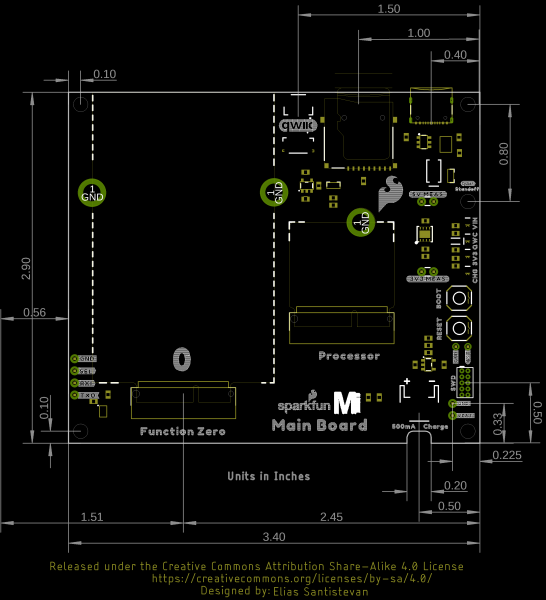 |
 |
| MicroMod Main Board - Single | MicroMod Main Board - Double |
